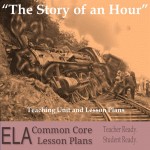If you thought you were stressed out about lesson plans, get a load of this story that came out of Chopin High School.
Knowing that Mrs. Mallard was afflicted with a heart trouble, great care was taken to break to her as gently as possible the news of her “Story of an Hour” lesson plan’s death.
It was her principal Ms. Josephine who told her, in broken sentences; veiled hints that revealed in half concealing. Her teacher friend Mr. Richards was there, too, near her. It was he who had been in the principal’s office when intelligence of the need for better “Story of an Hour” lesson plans was received, with Mrs. Mallard’s “read and answer the questions” lesson plans with no hint of a “Story of an Hour” analysis leading the list of “killed.” He had only taken the time to change his own lesson plans, and had hastened to forestall any less careful, less tender teacher in bearing the sad message.
Upon hearing the news, Mrs. Mallard had a heart attack and was never able to use the “Story of an Hour” lesson plans Richards had prepared.
But you can.
Let’s start with “The Story of an Hour” summary.

If you feel like your school needs to abandon the train wreck of boring lesson plans, you may want to get on board with “The Story of an Hour” teaching guide. It contains everything you see here, lesson plans aligned to the common core, graphic organizers with answer keys, essay rubrics to make grading easy, a copy of the story, and a quiz. These lesson plans will bring joy without killing anyone.
Richards tells Mrs. Mallard that her husband dies in a train wreck. He wants to be the one to break the news to her because Mrs. Mallard has heart problems. We find out soon enough that these heart problems are more than just physical. We also find out that Richards needs to shut his big fat face (more on that in a second).
Mrs. Mallard cries…a lot. She goes to her room, plops down on a chair, and stares out the window. She struggles to suppress her feelings-kind of like that time you struggled to suppress your joy after hearing that pain-in-the-a$$ kid in your 4th period fell down a flight of stairs running to P.E. and would be out for the next 6-8 weeks.
Her feelings are that of joy, that of excitement about being free from her husband’s rule. She contemplates how wonderful life will be.
Her nagging sister Josephine, not realizing that her ingrate sister is celebrating her good husband’s death, summons her downstairs. As the two women and Richards discuss matters at the door, Mr. Mallard walks in.
Mrs. Mallard has a heart attack and dies.
Mrs. Mallard dies from what the doctors call “the joy that kills.”
“The Story of an Hour” Analysis
Discussion ideas abound.

Life is good when your short story lesson plans are finished for the year.
- Setting. Understanding the theme of the story requires an understanding of setting in “The Story of an Hour.” Most students could probably figure out the story takes place in one hour in the Mallard home. They probably do not understand the social status of women in the late 19th-century.
- Teach how to annotate a short story - Annotating literature allows students to explore aspects of a literary work that interests them. Because “The Story of an Hour” is only 1,009 words and can be copied on to one slice of paper, it is ideal for annotating. Here are instructions for annotating a poem. Apply them to a short story and prepare yourself for an engaging, intelligent discussion.
- Irony is one of the hallmarks of Kate Chopin’s stories. If you really like irony (and who doesn’t), here’s a list of short stories for teaching irony that you can use for comparison purposes.
- Here are creative writing ideas: (1) Rewrite the story from Brently Mallard’s point of view; (2) Continue the story, telling the events of the next hour; (3) Modernize the story.
RL 9-10.1 Cite strong and thorough textual evidence to support analysis of what the text says explicitly as well as inferences drawn from the text.
RL 9-10.2 Determine a theme or central idea of a text and analyze in detail its development over the course of the text, including how it emerges and is shaped and refined by specific details; provide an objective summary of the text.
RL 9-10.6 Acquire and use accurately general academic and domain-specific words and phrases, sufficient for reading, writing, speaking, and listening at the college and career readiness level; demonstrate independence in gathering vocabulary knowledge when considering a word or phrase important to comprehension or expression.
RL 11-12.1 Cite strong and thorough textual evidence to support analysis of what the text says explicitly as well as inferences drawn from the text, including determining where the text leaves matters uncertain.
RL 11-12.6 Analyze a case in which grasping point of view requires distinguishing what is directly stated in a text from what is really meant (e.g., satire, sarcasm, irony, or understatement).
Procedures

This lesson can be done as you read or after you read “The Story of an Hour.” It can be done as part of a whole class reading or done as an individual reading, depending on the skill level and knowledge of students.
- Discuss irony. The graphic organizer handout lists the basics of irony and is sufficient for successful completion of the lesson’s objectives.
- Find examples of irony in “The Story of an Hour” and copy them in the chart.
- Identify the type of irony and write it in the chart.
- Interpret the irony and explain its significance to the overall meaning of the story.
- Discuss student discoveries with a small group and/or full class discussion.
- Optional: Write an analysis of irony in “The Story of an Hour.”
Assessment
The chart is an excellent opportunity to practice and discuss the lesson’s stated objectives. In most cases it should be considered a formative assignment.
Last Updated on May 2, 2018 by Trenton Lorcher
Share This: